20.02.2020
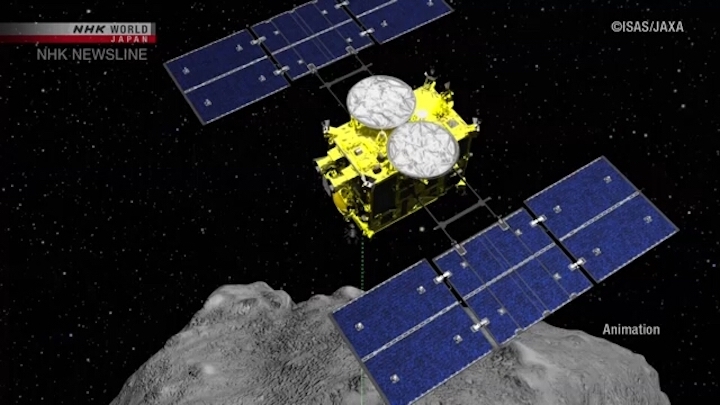
Japan's space agency says its asteroid probe is continuing its return to Earth as planned after the first injection of its main engines.
Hayabusa2 last December began its return after completing a mission on the asteroid Ryugu.
The Japan Aerospace Exploration Agency, or JAXA, on Thursday announced that Hayabusa2 completed the 880-hour injection of its ion engines.
Officials say the probe is about 239 million kilometers from Earth, traveling 24.35 kilometers per second as planned.
The engine's second injection is expected to start in May.
The agency plans to have the probe detach a reentry capsule expected to contain rock samples in November or December before landing in an Australian desert.
Agency officials say they're considering sending Hayabusa2 on a new mission, and hope to decide on concrete plans.
Mission manager Makoto Yoshikawa says the probe is working well, and that they will stay focused until the end through precise orbit control.
Quelle: NHK
----
Update: 29.02.2020
.
An iron-clad asteroid
Mineralogists from Jena and Japan make a surprising discovery on soil samples of the asteroid "Itokawa".
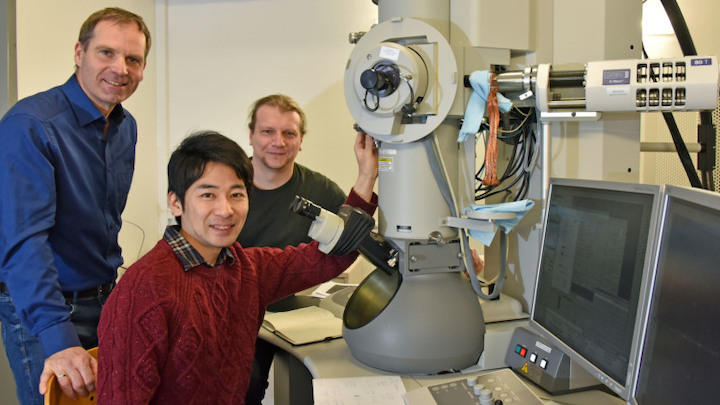
Mineralogists from Jena and Japan discover a previously unknown phenomenon in soil samples from the asteroid ‘Itokawa’: the surface of the celestial body is covered with tiny hair-shaped iron crystals. The team provides an explanation of how these were formed, and why asteroids can be unusually low in sulphur compounds, in the current issue of ‘Nature Communications’.
Itokawa would normally be a fairly average near-Earth asteroid - a rocky mass measuring only a few hundred metres in diameter, which orbits the sun amid countless other celestial bodies and repeatedly crosses the orbit of the Earth. But there is one fact that sets Itokawa apart: in 2005 it became a visit from Earth. The Japanese space agency JAXA sent the Hayabusa probe to Itokawa, which collected soil samples and brought them safely back to Earth — for the first time in the history of space travel. This valuable cargo arrived in 2010 and since then, the samples have been the subject of intensive research.
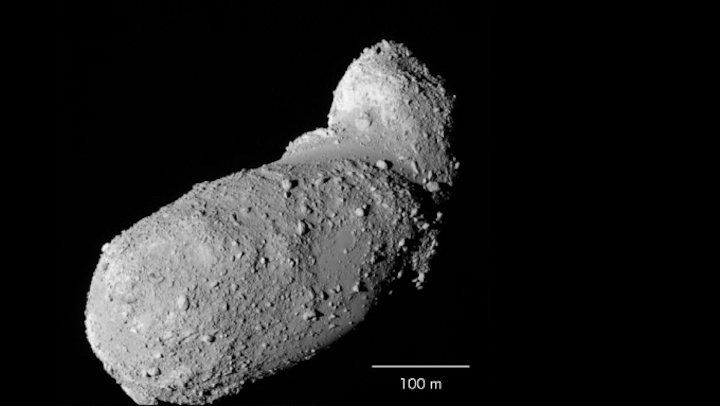
A team from Japan and Jena has now succeeded in coaxing a previously undiscovered secret from some of these tiny sample particles: the surface of the dust grains is covered with tiny wafer-thin crystals of iron. This observation surprised Prof. Falko Langenhorst and Dr Dennis Harries of Friedrich Schiller University in Jena. After all, over the last 10 years, research teams all over the world have exhaustively studied the structure and chemical composition of the dust particles from Itokawa, and no one had noticed the iron ‘whiskers’. It was only when Japanese researcher Dr Toru Matsumoto, who is spending a year as a visiting scientist with the Analytical Mineralogy group at the Institute of Geosciences in Jena, examined the particles with a transmission electron microscope that he was able to locate the crystals using high-resolution images.
Solar wind weathers celestial bodies
This discovery is exciting not only because the tiny iron ‘whiskers’ - which have since been shown on other particles from the asteroid as well - had previously been missed. Of particular interest is how they were formed. "These structures are the consequence of cosmic influences on the surface of the asteroid," explains Falko Langenhorst. In addition to rocks, high-energy particles from the solar wind also strike the asteroid’s surface, thus weathering it. An important constituent of the asteroid is the mineral troilite, in which iron and sulphur are bound. "As a result of space weathering, the iron is released from the troilite and deposited on the surface in the form of the needles that have now been discovered," says the mineralogist Langenhorst. The sulphur from the iron sulphide then evaporates into the surrounding vacuum in the form of gaseous sulphur compounds.

From the size and number of the ice crystals detected, the researchers can also estimate how quickly the asteroid loses sulphur. "The process is incredibly fast from a cosmic perspective," explains Toru Matsumoto. The crystals he analysed are up to two-and-a-half micrometres long, which is around one-fiftieth of the thickness of a human hair. "The tiny whiskers have already reached these sizes after around 1,000 years," adds the researcher from Kyushu University in Fukuoka. Over the long term, the analysis of the ice crystals can be used to gain a better understanding of weathering processes on other celestial bodies as well, and to determine their age.
To this end, the researchers already have specific asteroids in their sights. NASA’s OSIRIS-REx probe is currently preparing to take samples from asteroid Bennu, while JAXA’s Hayabusa2 is already on its way back to Earth. The Japanese probe visited the Ryugu asteroid last year and, as with Itokawa, it collected dust particles. The samples should land on Earth at the end of 2020 and the international team of Jena mineralogists and Toru Matsumoto are awaiting them with anticipation
Original publication:
Matsumoto T et al. Iron whiskers on asteroid Itokawa indicate sulfide destruction by space weathering. Nature Communications (2020), DOI: 10.1038/s41467-020-14758-3, https://www.nature.com/articles/s41467-020-14758-3
Quelle: Friedrich Schiller University Jena
----
Update: 18.03.2020
.
The asteroid Ryugu has a texture like freeze-dried coffee
This porous space rock could reveal details of how planets formed
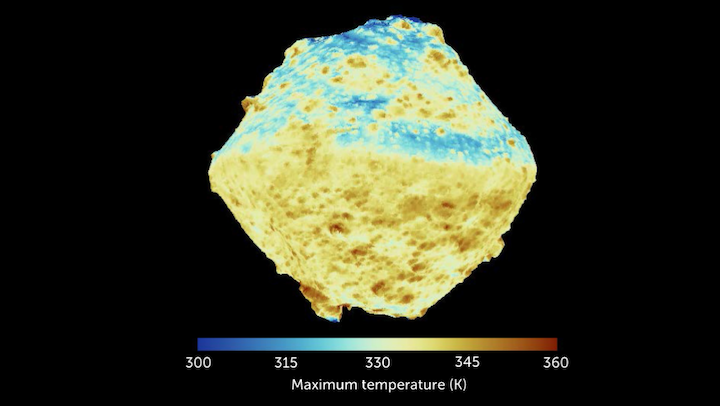
The Hayabusa2 spacecraft measured the maximum temperatures during one full rotation of the asteroid Ryugu and found that most of the asteroid stays cool. Blue regions are around 300 kelvins (27° Celsius) and yellow are around 330 kelvins (57° C). Just a few hot spots, in red, were dense boulders that reached 360 kelvins (87° C).
The asteroid Ryugu is light and fluffy. Images taken by Japan’s Hayabusa2 spacecraft suggest the whole asteroid is highly porous, scientists report in Nature on March 16.
“It is something like freeze-dry coffee,” says planetary scientist Tatsuaki Okada of the Japanese Aerospace Exploration Agency. If early protoplanets had similar structures, that could mean planets formed quickly.
As an ancient, carbon-rich asteroid, Ryugu is thought to be a time capsule of solar system history. To read that history, Hayabusa2 explored Ryugu from June 2018 to November 2019, and grabbed two samples from the asteroid to bring back to Earth (SN: 7/11/19).
Hayabusa2 observed how the asteroid’s surface retained and released heat, a clue to its composition and structure. Dense rocks take in heat slowly and hold that heat for longer; more porous rocks change temperature quickly, like sand on a beach.
Ryugu’s heat map shows that it’s about 50 percent porous, meaning half of it is holes, Okada and colleagues report. Even most of the asteroid’s large boulders appear porous.
That airiness fits with the idea that Ryugu is a rubble pile formed after the breakup of a larger body some 700 million years ago (SN: 3/20/19). But the new observations suggest that parent body might have been porous, too.
“This might be common for the asteroids and even for planetesimals in the early solar system,” Okada says.
If true, it could have big implications for how quickly planets formed. Planetary scientists think the early solar system was a violent place, with protoplanets colliding, breaking up and re-accumulating all the time. Porous protoplanets might fall apart and come together again more easily than dense ones, Okada says. That means “the timescale of planetary formation may be changed drastically,” and planets might have formed faster than scientists thought, he says.
Quelle: ScienceNews
+++
Rocks on Asteroid Ryugu Unexpectedly Porous: JAXA-Led Team
Thermal imaging data have shown that rocks on the surface of asteroid Ryugu are unexpectedly porous, a team of the Japan Aerospace Exploration Agency, or JAXA, and others said Tuesday.
The thermographic images indicate that "the asteroid's boulders and their surroundings have similar temperatures," the research team led by Tatsuaki Okada, associate professor at JAXA, said in an article published in the online version of science journal Nature.
"Contrary to predictions that the surface consists of regolith and dense boulders, this low thermal inertia suggests that the boulders are more porous than typical carbonaceous chondrites," the team said.
The thermographic images were taken by the Hayabusa2 unmanned spacecraft using a mid-infrared camera. Rocks on the asteroid "look like instant coffee powder that will easily fracture if you pick it up," Okada said.
The images also suggest that there are some dense boulders with colder temperatures, according to the research team.
Quelle: nippon.com
----
Update: 21.03.2020
.
Bombing asteroid Ryugu reveals it is a spritely 9 million years old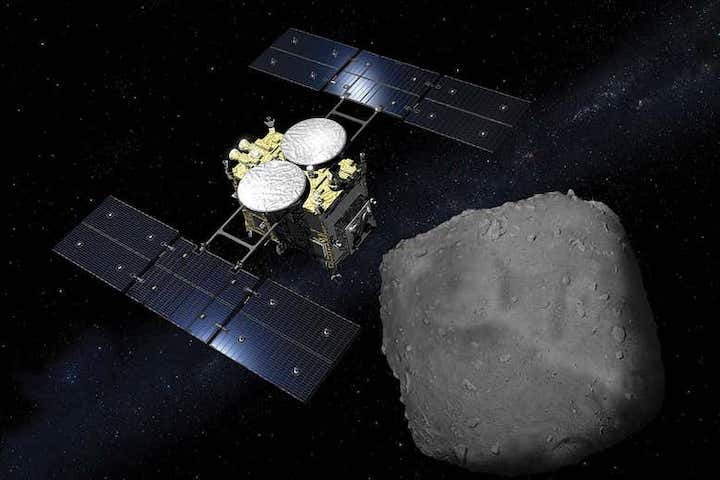
Bombing an asteroid has taught us its age. In April, the Japanese Hayabusa 2 spacecraft launched a copper projectile at the asteroid Ryugu, and now we have the first data on the crater it left behind.
The main purpose of the experiment was to collect a pristine sample of the material underneath the asteroid’s surface. Masahiko Arakawa at Kobe University in Japan and his colleagues analysed images of the collision to study the crater formation process.
When the 2-kilogram projectile smashed into Ryugu, it blasted away the sand and rocks where it hit, and even moved a 5-metre wide boulder. The resulting crater was about 14.5 metres wide and 2.3 metres deep.
“This is the first time that we have observed the crater formation process in a microgravity environment,” says Arakawa. Most of our understanding of how craters are formed is from laboratory experiments here on Earth, he says.
Asteroid age
That is important because we use the number and size of craters on asteroids to estimate how old they are. Previous studies of Ryugu determined that it was either about 9 million years old or about 160 million years old, depending on how much the size of craters there is limited by the strength of the asteroid’s surface.
From observing the formation of this new crater, the researchers found that underneath its blanket of boulders Ryugu’s surface isn’t very sturdy. It is more like sand than rock. They say this confirms that Ryugu is only about 9 million years old.
Asteroids like Ryugu form when larger objects get smashed up and the remnants reaccumulate into “rubble piles”. There is usually lots of debris left behind from such a smash-up, creating what astronomers call a family of objects that all come from the same parent body.
“We may recognise the family in the asteroid belt in the future,” says Arakawa. That may be easier than we expected, because the parent body broke up relatively recently, suggesting the shattered pieces should be closer together.
Quelle: NewScientist
----
Update: 13.04.2020
.
Creating a crater to constrain the age
of an asteroid’s surface
An important science goal for the Hayabusa2 mission is to map the history of asteroid Ryugu. As a primitive carbonaceous asteroid from the early days of the Solar System, Ryugu’s life traces the movement of ices and organics; the ingredients for habitability.
With the majority of information about the asteroid gathered from detailed observations, a key question for constructing a chronology is the age of that observed surface. Dating of surfaces of celestial bodies is done by counting the size and frequency of craters. Comparing such counts with the expected rate of impacts yields a value for the surface age.
However, these age estimates can be very uncertain. The first assessment of the Ryugu surface suggested the asteroid had stayed in the asteroid belt (where collisions mainly occur) anywhere between 6 million and 200 million years: a range covering over an order of magnitude. This uncertainty is due to not knowing how the material of Ryugu’s surface responds to an impact. In particular, what force stops a crater growing?
When a crater cavity forms, it must fight against the mechanical strength of the rock to break it apart, and also gravity that resists material being thrown outwards. Which force ultimately determines where the evacuation of the surface stops affects the size of the final crater. The sizes of craters that cover a surface therefore depend on if crater generation is strength limited or gravity limited and an accurate assessment of age requires knowing which is dominating.
On Earth, craters with diameters more than a few 10s of metres are gravity dominated. Ryugu’s gravity is much lower at only approximately 0.00001 G (1 G = Earth gravity), but its surface material may also be weak, resulting in no obvious winner between the two forces.

ONC images of the SCI crater. (A) The area prior to the impact, taken from an altitude of 1.72km. MB marks the Iijima boulder, SB is the Okamoto boulder. (B) Same location after the impact. (c) SCI crater is marked with the yellow semi-circle and the white box is the region shown in (D) with the small pit marked. (Figure 1 in Arakawa et al, Science 2020.)
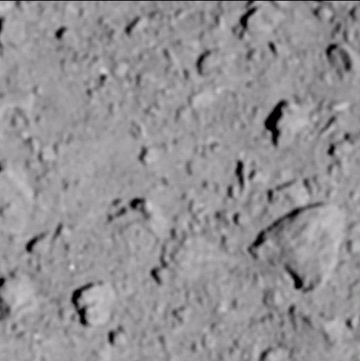
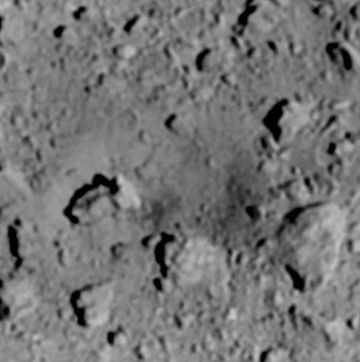
Models and simulations of crater formation highlight differences in the velocity and distribution of ejecta generated in both the strength and gravity limited scenarios. But to observe this, the crater-forming process has to be caught in action. This was achieved on 5 April, 2019 when Hayabusa2 released the small carry-on impactor (SCI).
In a paper published today (19 March, 2020) in Science Magazine, a team led by Masahiko Arakawa (Kobe University) scrutinised the formation of the SCI-generated crater for evidence of the forces dominating the evacuation.
The SCI is a 2kg copper projectile that struck the surface of Ryugu at a speed of 2km/s. While the main spacecraft moved away from the impact site to avoid the resulting debris, the collision was observed by a deployable camera, DCAM3. Three weeks later, the new crater was imaged by the onboard telescopic optical navigation camera (ONC-T) as the spacecraft descended to 1.7km over the impact site.
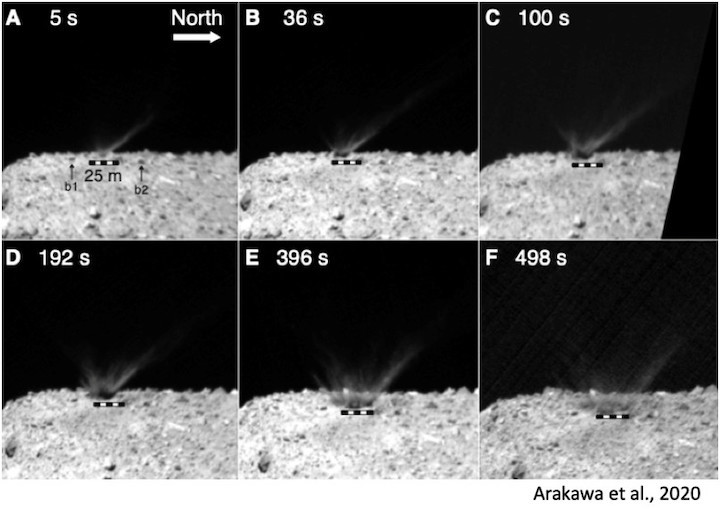
DCAM3 images of the SCI impact at different elapsed times after the collision (Figure 3 in Arakawa et al, Science 2020).
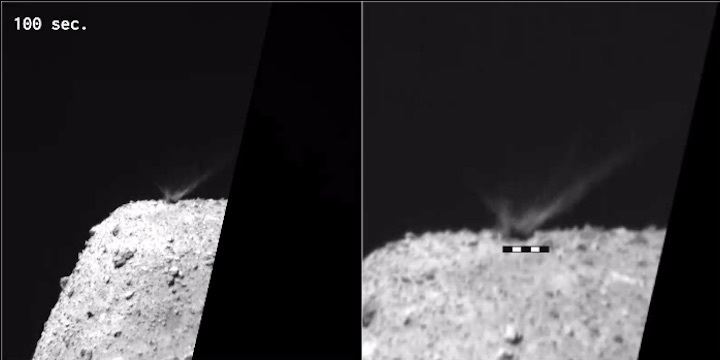
The heavily bouldered surface of Ryugu prevented the creation of a symmetrical crater. The SCI impact moved dozens of these rocks, including the 5m Iijima boulder, which was shifted 3m to the north-west of its original position. However, the Okamoto boulder to the south remained immobile and seems to have blocked crater growth. The result was a semi-circular crater with the ejecta thrown towards the north-west. Observed via the DCAM3, the ejecta itself was split into rays by boulders that blocked the evacuation flow of material.
Measured across at the original surface elevation, the new crater was 14.5m in diameter and 17.6m when measured across the raised rim. This is seven times larger than the crater generated in a similar impact on Earth, due to the much weaker gravity and surface strength. A small pit was also formed close to the impact site, implying that Ryugu may have a layered structure, with a harder layer containing the pit overlaid with a fluffier surface material.

A) DCAM3 image of the ejecta created during the SCI impact, with four separate rays of material. (B) ONC optical image of the impact site, with numbers corresponding to the ejecta rays in (A). (C). Change in reflectivity before and after the SCI impact. Darker regions are thought to indicate material ejected from below the surface. (Figure 4 in Arakawa et al, Science 2020.)
The ejecta observed by DCAM3 provided two vital clues to the forces at work. Firstly, the curtain of ejecta remained attached to the ground. Previous laboratory experiments suggest that this is seen when gravity is limiting the crater evacuation, but not in the strength-limited case. The second clue was material in the ejecta was at least partially deposited on the crater rim. Models of the velocity of such evacuated particles suggest this is also a sign of gravity-limited crater formation.

Ryugu history. ※1 : Theoretical calculations and astronomical observations estimate the typical lifetime of near-Earth objects as about 10 million years. (JAXA)
For the weak gravity of Ryugu to be dominating the crater formation process, the asteroid’s surface material must an extremely low strength. A comparison would be a cohensionless material such as sand, whose strength originates from friction that depends on the (weak) surface gravity.
Scaling laws that predict crater size suggest that the SCI should generate a crater with radius 6.9 - 7.7m in the case where gravity is dominating. This agrees well with the apparent radius of 7.3m.
If the size distribution of craters on Ryugu’s surface is determined by gravity, then the asteroid’s surface age is at the younger end of the predicted range. The SCI experiment suggests Ryugu stayed in the asteroid belt for between 6.4 and 11.4 million years. After this time, the orbit of Ryugu would have changed as it entered the inner Solar System to become a Near-Earth Asteroid (NEA). In this more empty part of space, collisions become far less frequent and it becomes hard to judge the passing of time. Roughly speaking, NEAs are estimated to exist for about 10 million years.
There is one caveat. Any major change in surface topology that erases old craters effectively re-sets the surface age clock. It is therefore not possible to tell if 10 million years has passed since Ryugu was first formed, or if this has been the time since a global resurfacing event. Distinguishing between these scenarios will be the subject of future work on this fascinating asteroid.
Quelle: JAXA
----
Update: 9.05.2020
.
RYUGU MAY HAVE SKIRTED CLOSE TO THE SUN
Observations by the Japanese Hayabusa 2 spacecraft show subtle color differences, indicating something has reddened the asteroid’s surface.
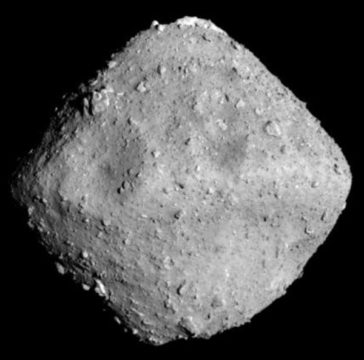
JAXA / University of Tokyo and collaborators
A combination of craters and surface color suggests that the near-Earth asteroid 162173 Ryugu was cooked by the Sun between a few hundred thousand and several million years ago — and that the asteroid might be remarkably younger than previously predicted.
The Japanese spacecraft Hayabusa 2 accompanied Ryugu around the Sun for nearly 17 months, observing it with cameras, dropping rovers, and touching down twice to pick up samples of surface rubble. The craft’s observations revealed a die-shaped world strewn with countless boulders that are surprisingly dry, as I describe in our May 2020 issue.
As Hayabusa 2 now wends its way home, mission scientists are working to interpret what the craft saw on the kilometer-size asteroid. These assorted observations enabled scientists to study the asteroid in detail, even down to how the surface reacted when blasted with the spacecraft’s hydrazine thrusters.
JAXA / U. Tokyo / Kochi U. / Rikkyo U. / Nagoya U. / Chiba Inst. Tech. / Meiji U. / U. Aizu / AIST
The combined data show an oddly striated world. Ryugu’s equator and poles are tinged blue and are brighter compared with its darker, reddish mid-latitudes. These color differences wouldn’t be obvious to the human eye, although the brightness changes might be. Broken surfaces and boulder edges often look bluer; ragged, older surfaces look redder. During Hayabusa 2’s first touchdown, it also kicked up a cloud of dark, fine reddish grains and scattered boulders, including one the team dubbed Turtle Rock that seemed to be sandblasted bright by the exhaust.
As Tomokatsu Morota (University of Tokyo) and colleagues write in the May 8th Science, Ryugu’s boulders likely start bluish. Then a combination of solar wind exposure, meteoroid impacts, and solar heating reddens them. This redder stuff migrates to the asteroid’s mid-latitudes over time, because topographically those are the lowest on Ryugu’s surface. That movement leaves the higher equator and polar regions relatively bluer and brighter.
JUST HOW LONG AGO WERE RYUGU’S ROCKS REDDENED?
Surface reddening is no surprise; planetary scientists have seen it on other kinds of asteroids. And although meteorite experiments a few years ago had suggested C-class asteroids like Ryugu would become bluer due to space weathering, recent follow-up experiments indicate that porous, dehydrated surfaces like Ryugu’s might indeed redden with time.
But the reddening reaches too deep into the surface to be due to normal space weathering, the authors argue. Red ejecta dug up by impacts streak the surface, and some small craters are actually redder than their surroundings, suggesting the red stuff is as least a few meters deep.
Furthermore, craters on Ryugu seem to fall into one of two groups, the team found: red or blue. There’s no gradual change. The dichotomy suggests that the reddening was an event, not a continuous process, and it happened before the blue craters were created.
Putting these data together, Morota and colleagues argue that Ryugu ventured too close to the Sun and was baked.
To pinpoint when this heating might have happened, the researchers looked at the red and blue craters’ sizes. Based on the number of craters of different sizes, they estimate that Ryugu went on its solar “excursion” between 300,000 and 8 million years ago, depending on whether it took the punches that made the craters in the region around Earth or in the main belt, before it came to the inner solar system. They also estimate that the heating happened some 8.5 million years after the asteroid’s formation. That would make Ryugu at most about 17 million years old.
This age is surprisingly young. Based on Ryugu’s orbit, scientists thought the little world was built from the debris of an asteroid smashup that happened in the main belt roughly a billion years ago — perhaps the same one that created Bennu, the target of NASA’s ongoing Osiris-Rex mission. Maybe multiple generations of asteroids formed and broke up before Ryugu coalesced, the authors suggest.
But the age estimates are far from certain, cautions Osiris-Rex scientist Daniella DellaGiustina (University of Arizona), who heads up that mission’s image processing. It’s still possible that space weathering, pulverization, and even carbon could redden the rocks, she explains. Also, scientists don’t know whether asteroids of this size and porosity react to large crater-making impacts the same way other bodies do.
Hayabusa 2 scientists take confidence from the shape of the crater blasted into Ryugu by their Small Carry-on Impactor (SCI), a 30-cm-wide copper disk mangled into a bullet and shot at the asteroid. But that was a relatively small hit, she says.
Study coauthor Seiji Sugita (University of Tokyo) acknowledges they’re taking a risk with their age prediction. But “we felt that this is a one-of-a-kind opportunity to predict and test,” he says. Researchers will be able to confirm Ryugu’s surface age once they test Hayabusa 2’s samples, which will drop in Australia this December. There’s more to be gained by going out on a limb and making a bold prediction, he says. “This is the best way to examine how well we understand nature.”
One final note: the proposed heating event couldn’t explain why Ryugu’s minerals show so little evidence of interacting with water, the Hayabusa 2 scientists write. The bluish, brighter regions are just as dry as the reddish ones.
Quelle: Sky&Telescope
+++
Some clues to Ryugu’s odd colours
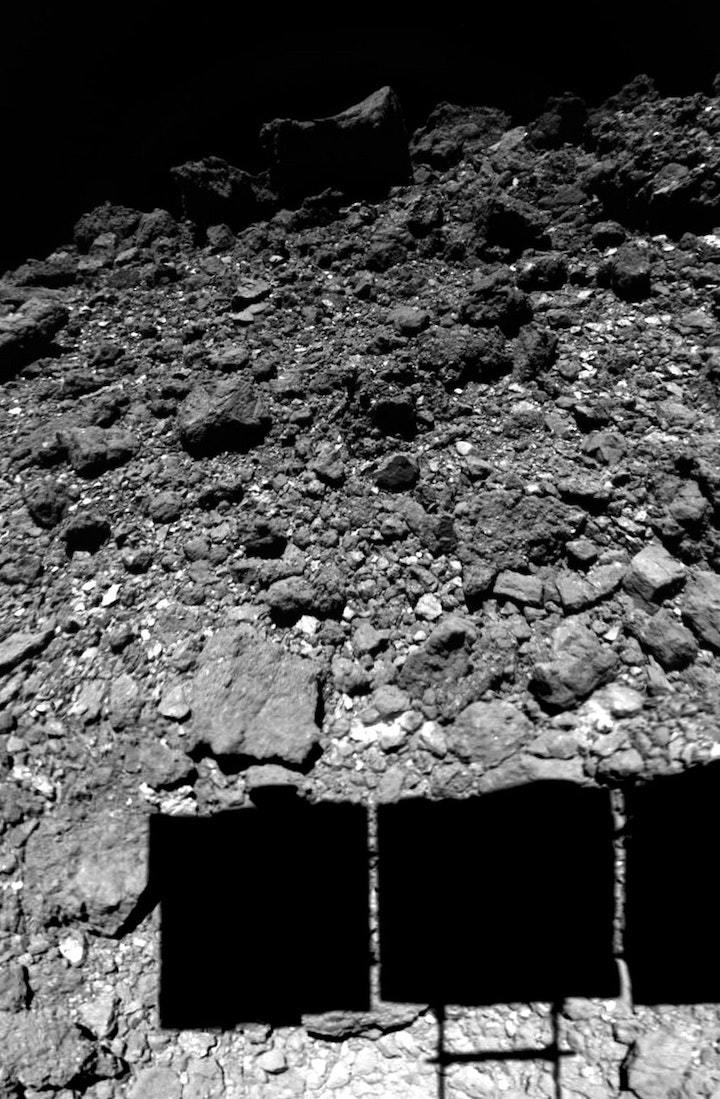
JAXA/U. TOKYO/KOCHI U./RIKKYO U./NAGOYA U./CHIBA INST. TECH./MEIJI U./U. AIZU/AIST
When Japan’s Hayabusa2 probe landed on Ryugu in February last year, it provided the opportunity not only to collect a few rocks from the asteroid but also get a close-up view of its surface.
And in doing so, it may have shed light on one of its curiosities – why it appears as different colours in different regions.
A carbonaceous asteroid that orbits mainly between Earth and Mars, Ryugu intrigues researchers, and Hayabusa2 was launched in 2014 with an ambitious plan to bring back some samples.
For around 18 months it studied the asteroid from a distance, capturing stunning images which highlighted one mysterious quirk – Ryugu is blue in the equatorial and polar regions, and red in between.
Now, high-resolution images and video taken during the probe’s first touchdown (there has since been another) suggest that these variations are likely due to rapid solar heating during a previous orbital excursion near the Sun.
The results are published in the journal Science.
Studying the images and analysing their spectral properties, Tomokatsu Morota from the University of Tokyo and international collaborators observed that the spacecraft’s thrusters disturbed a thin layer of dark grains of material on the surface of the asteroid that corresponded with the red material.
Interestingly, the chosen landing site initially appeared bluer, and nearby boulders were mostly blue. After the settling of the dust cloud, the area surrounding the lander became redder in appearance.
When the team examined images from when the sampler itself fired into the surface of the asteroid, they also noticed it produced a cloud of dark, fine grain particles.
“These observations suggest that dark, fine grains were originally present on the surfaces (or inside the pores) of darker and redder boulders,” they write.
During initial surveys and its descent, Hayabusa2 also captured images of the wider asteroid surface, which revealed that recently formed craters were spectrally bluer than their surrounding areas.
Together the authors suggest these findings are compatible with a theory that the darker red material is not compositionally different to the brighter blue material of Ryugu. Instead, Ryugu’s boulders and surface were originally bluer in colour, but were darkened by solar heating.
Furthermore, they write that the surface reddening has not been occurring throughout Ryugu’s life. Older craters whose spectral characteristics matched the surrounding area and newer craters which were brighter than the surrounding area allowed them to create a timeline of Ryugu’s reddening.
Based on the relative size and distribution of craters compared to the expected frequency of the asteroid being struck by objects, the researchers estimate that the reddening event must have occurred around 8.5 to nine million years after Ryugu formed.
With there being only 3% as many blue craters compared to red, they estimate that it’s been another 300,000 years to eight million years since that reddening event occurred.
“We suggest that a surface reddening event within a short period of time could be explained if Ryugu underwent a temporary orbital excursion near the Sun, causing higher surface heating,” they write.
At some point, after its orbit shifted from the main asteroid belt to a near-Earth orbit, Ryugu made a close orbit of the Sun during which the intense heat discoloured and weathered its surface layers, turning it red.
Over time, some of this surface regolith layer moved away from the poles and equatorial region through mass wasting, impacts and thermal fatigue, creating the colour pattern seen today. The red regolith also mixed with the blue, unaltered, layers underneath, creating a mixed layer metres thick. During this time, impacts also blasted away some of the surface layer, leaving young bright craters.
Hayabusa is currently travelling back to Earth with its rocky cargo and will touch down in Australia in December this year.
Animation created from ONC-W1 at the bottom and ONC-W2 on the side of the spacecraft.
CREDIT: JAXA/U. TOKYO/KOCHI U./RIKKYO U./NAGOYA U./CHIBA INST. TECH./MEIJI U./U. AIZU/AIST
Quelle: COSMOS
